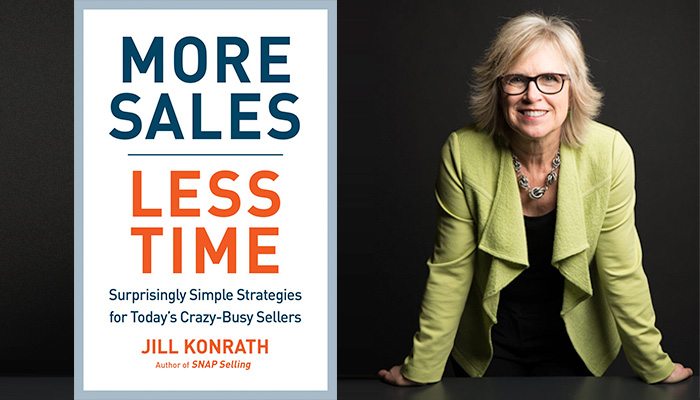Keynote speaker and sales acceleration strategist Jill Konrath knows how important productivity is when it comes to keeping up with ever-changing sales technologies.
In “More Sales, Less Time: Surprisingly Simple Strategies for Today’s Crazy-Busy Sellers,” Konrath explains why typical time management techniques do not work in a sales environment. Instead, she presents research-backed strategies specific to those in small business sales.
Konrath offers advice on how to optimize sales processes, how to free up time to focus on tasks that have the highest impact on sales results, how to reclaim (at minimum) one hour per day by eliminating time sucks and more.
In Chapter 13, “Design a Better Way,” Konrath explains how to find a better system of working that will optimize your time and help you get more done at work.
The following excerpt was selected for StartupNation readers and is reprinted from “More Sales, Less Time” by Jill Konrath with permission of Portfolio, an imprint of Penguin Publishing Group, a division of Penguin Random House LLC. Copyright (c) Jill Konrath, 2016.
In sales, systems outperform miracles. We can’t expect to reduce our working hours and drive more revenue unless we get serious about how we spend our time. Minimizing distractions is a good start. Knowing key priorities is essential too. But they’re still insufficient unless we have the right kind of plan in place.
For most of my life, I’ve been clueless that highly productive people think and act differently from me. They take their time seriously. If you looked at their weekly or daily calendar, it would be fully mapped out and optimized with activities to reach their objectives.
As a comparison, for much of my working life, my calendar was filled with lots of white space interspersed with scheduled meetings. While I fully intended to use that unslotted time to get important work done, it often never happened. Instead, I frittered it away reacting to other people’s priorities. As Cal Newport, author of “Deep Work,” writes, “If you don’t give your time a job, it will dissipate into a fog of distracted tinkering.”
That was my situation exactly and probably yours, too. There’s no way we’re going to meet our goals unless we spend time organizing time.
Highly productive sellers start their week on Sunday night. They take twenty to thirty minutes to review what’s on their calendar for the week ahead.
That’s where we need to begin. Think about your ONE Thing, making sure you have time on your calendar for your priorities. Double-check that you have enough prospects in your pipeline. Figure out what you need to do to advance your existing opportunities. If you need planning time, put that on your calendar.
Then, use these strategies to power-pack your schedule.
Related: Transform Your Life and Business [Book Excerpt]
Work in time blocks
One of the most productive things you can do is to view your day as four to five work segments broken up by short breaks. Ask yourself, “What can I realistically get done in sixty to ninety minutes?”
In “The Way We’re Working Isn’t Working,” author Tony Schwartz suggests we need to work in sprints because this aligns with our naturally occurring body rhythms.
Every hour and a half, our body enters a period of drowsiness where it’s tougher to think and work. Trying to push through it makes no sense.
In that time frame you could call twenty prospects, put together a simple proposal, or plan for an upcoming meeting. You also have enough time to get in the flow, which means you’ll be working at your optimal level. Occasionally, you may overestimate how much you can actually get done, so pay attention to what’s really feasible.
Group similar activities
We want to avoid multitasking at all costs.
According to the American Psychological Association, shifting between tasks can cost as much as 40 percent of a person’s productive time.
Multitasking also reduces our IQ. Here are some ways to group your work:
- Prospecting: Most sellers don’t realize that prospecting is a series of very different activities: researching, planning, calling, e-mailing and recording. You’ll be much more productive if you separate this work into different time slots. For example, you might start with online research, jotting down relevant ideas, insight, and information. After that, set aside dedicated planning time where you craft your messaging. In the next block of time, make your calls. Finally, after they’re all done, enter the info from your outreach into your CRM.
- Proposals: If you have to put together several proposals, do them one after the other. You’ll get your mind in the proposal-writing mindset. This enables you to think at a higher level and do better work.
Build in buffers
Scheduling important meetings back-to-back is a recipe for disaster. If you’ve ever had to cut short a great meeting with a highly engaged prospect, you know what I mean: you spend the last few minutes of your conversation trying to figure out how to bring it to a close at the same time you’re sending an e-mail to your next prospect, telling them you’re running a few minutes late. Then, when you do get on the next call, you’re flustered and don’t perform at your best.
To prevent that common issue from happening, build in fifteen-minute buffers between meetings. Even if things do end on time, you have a few extra minutes to debrief and think about your next steps while the meeting is still fresh in your mind. As an added bonus, you have extra time to prep for your upcoming meeting, ensuring that goes well too.
Build in buffers when you’re switching tasks, too. Allow yourself time to finish thinking about one or slowly immerse yourself mentally in your next project.
Look around you
If you’re a field sales rep, one of the best ways to maximize your time is to plan your day around a physical location. Jeb Blount, author of “Fanatical Prospecting,” says:
“The best salespeople map their territory by day. Then they plan their appointments and calls each day, within the grid, thus reducing drive time. The key is leveraging the CRM to run call lists by geography-based attributes.”
Jana K., a multiyear top seller at a software company, is a master at this. She’s on the road frequently, often sponsoring association meetings attended by her parochial-and private-school clients. Using her CRM’s mapping tool, she can quickly identify clients and prospects in the same area as the upcoming event and set up times to meet with them. She is a master at maximizing her travel time.
Even if you don’t have this capability, that’s no excuse for not looking around. Your time is too valuable to waste. One of my clients is in the eyewear business. Their reps often drive a considerable distance to meet with opticians scattered across the country. Their top sellers set up meetings with other optical shops in towns along the way, ensuring the value of their trip.
Related: Sign up to receive the StartupNation newsletter!
Set a quitting time
If you feel overwhelmed, this sounds like an impossibility. If you work from home, your office (and work) is always beckoning. However, one of the smartest things you can do is say, “I’m out of here at [your time]”—and mean it. Literally at the magic hour, you shut things down and walk out.
Having a quitting time forces you to plan better. You’ll be far less tolerant of any interruptions and distractions, even self-generated ones. I discovered that several years ago. My husband and I decided to spend a month in warm southern Utah to escape Minnesota’s brutal winters. While there, I quit work every day at 2:30 so we could go out hiking. I got up a little earlier, but mostly I was just more efficient because I knew I had a stopping time.
Yes, there are times when you can’t leave at the designated hour. You’re in a meeting that’s going on and on or you need to finish a proposal your prospect is expecting by the end of the day. There’s a customer issue that must be resolved. Your boss needs to talk with you about your forecast.
Or, you may leave at quitting time but still have some work that needs to get done later. Many busy people incorporate a split schedule in order to accommodate other important things in their life—like kids, volunteer work, and fun. Having that quitting time is a great incentive to be more productive while also having a fuller life.
Use these guidelines to create a system that works for you. Again, think system—something you do every single day because it works, a plan that gets you to the end result you want. According to motivation expert Heidi Grant Halvorson, goal achievement success rates go up 200 to 300 percent with the right kind of planning.
If you’ve never implemented a system to work by, it’s a big change. But I can tell you this: I’m beginning to love a system, especially one that I’ve designed myself. Structure is freeing and systems work.






